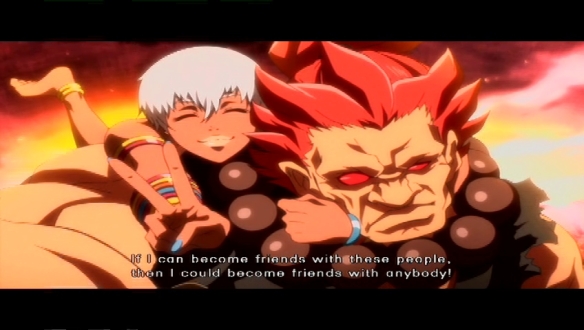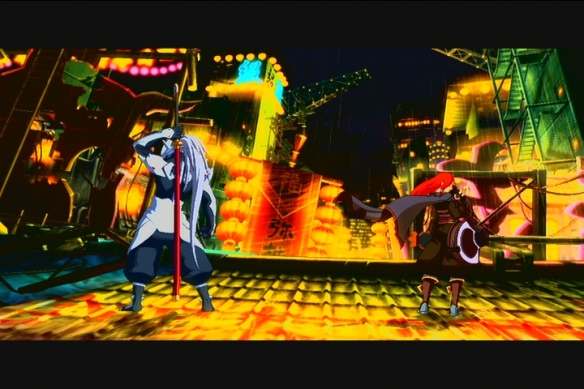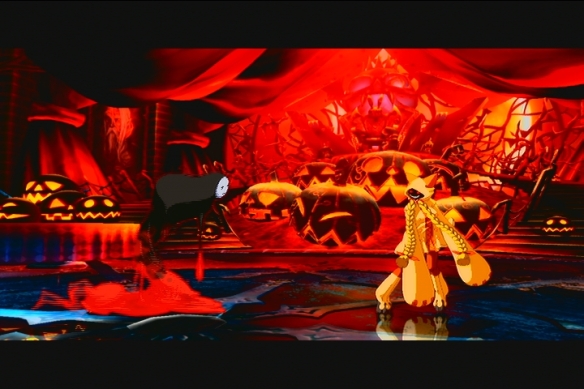It was supposed to be over. The heroes of Persona 3 and 4 banded together in Arena and uncovered yet another mystery plaguing the town of Inaba. Old friendships were tested, new connections were made, and Labrys – the unwitting catalyst of the whole ordeal – was given a second chance at life. The two groups parted ways amicably, but there was an unspoken understanding that, if anything were to happen, both groups would cross paths again. Mitsuru and the rest of her Shadow Operatives left town in search of mastermind behind the tournament. Yu and his Investigation Team settled back into their daily lives, trying to make the most of the remaining holiday before splitting up again. For that one day, it seemed like everything was finally back to normal. They failed to realize one simple, terrifying truth:
The tournament never stopped.
And this time, the stakes have been raised. The lights have gone out across Inaba, and everyone except Persona users have vanished without a trace. A thick, red fog is slowly consuming the town, warping the streets and buildings into an unrecognizable labyrinth. Yasogami High, the Investigation Team’s school, has transformed into an impossibly tall, ominous tower. If any of the Persona 3 cast were still around, they’d be able to explain how the whole thing looks like Tartarus, the otherworldly dungeon they conquered… But they’re not here. Whoever is running the tournament learned from previous mistakes; the villains’ first move was to ambush the Shadow Operatives. Now Mitsuru, Akihiko, Aigis, and Fuuka – previously established as the most powerful and well-connected heroes in Arena – are being held as hostages at the top of the tower. Their backup team is en route, but it may be too little, too late. There are new monsters lurking in the fog, and several of them are evil shadow versions of the heroes. With no other options, Yu and the rest of the crew have to step up. They better hurry, too; if they don’t finish the tournament in an hour, the world will end.
Yeah, things just got real. Ultimax fixes the poor pacing and reused conversations that plagued Arena’s narrative by presenting the story on a much grander and streamlined scale. Rather than having to dig through each character’s perspective, everything is presented on a simple, branching map. Characters meet and team up, which makes the journey progress much faster. Since the fights take place across Inaba instead of the TV World, there’s more opportunity for characters to branch out and have more realistic interactions. Aside from a couple of prompts in the endgame, it’s impossible to miss or change anything. There are no repetitive scenes or reasons to play through a second time. That being said, the story is just as long as last time; if you don’t use the dialogue skipping option, it’ll take nearly ten hours to see everything. While Arena was a deconstruction of fighting games – particularly the idea of friends fighting each other to the death – Ultimax is a much more straightforward adventure. If anything, the previous game was merely setting everything up for the main event. The bad guys drop all subtlety and actively encourage you to fight. Sho Minazuki, the new antagonist, isn’t nearly as interesting as he could have been; there’s not enough screen time to allow him the kind of character study that Labrys received. The players are only given the unspoken implications of unnatural human experiments and the rejection of the series’ concept of friendship.
On the other hand, the story acts as a much-needed follow-up to Persona 3. Yukari, Junpei, Ken, and Koromaru, the remaining members of the Shadow Operatives, finally return to the center stage. They’ve grown since their last outing (Junpei has notably become the most down-to-Earth member on the team, and Ken isn’t nearly as insufferable), and there are tons of callbacks to their previous quest. Persona 4 fans, however, will likely care more about the appearance of Adachi. It’s impossible to explain why he’s so important without getting into spoilers, but he is not just a guest fighter; his inclusion is a key part of the story, though not in ways Golden veterans will assume. Marie and Elizabeth don’t get as much screen time for narrative reasons, but Rise’s surprise addition as a playable character more than makes up for it. The designers carefully considered her abilities in the RPGs and made her even more formidable. Regardless of which characters or games you prefer, Ultimax serves as an excellent crossover.
But if you’re a newcomer to the series, don’t worry. The narrative does a decent job of summarizing everything you need to know. If you’re only interested in fighting, the Arcade and Versus Modes are easily accessible. There are over 20 available characters – Adachi, Marie, and Margaret are DLC – each with unique play styles and their signature attacks from the RPGs. Yukiko practically dances across the battlefield with her fans, gracefully roasting her victims to death. Junpei’s accumulating hit power mechanic is taken straight from Guilty Gear’s Sol Badguy. The fighters’ Personae – their inner personalities given form as deities – can be summoned to augment your tactics. For example, Mitsuru is a powerhouse up close, but Artemisia helps her punish and freeze enemies from mid to long ranges. Everyone has the usual assortment of ground and air dashes, short hops, throw techs, tactical blocking, countering, evasive rolls, and even Instant Kills. Most of the specials, status ailments, and super attacks are done via the quarter circle and charge commands you’d find in any other fighting game, though Ultimax strongly emphasizes move canceling and connecting hits. By no means is it as technically demanding as its BlazBlue sister series, but it can still be overwhelming for newcomers. If you’re having trouble, you can just mash the weak attack button to launch a brief automated combo. It’s a cheap, shallow mechanic for experienced players, but it’s the perfect crutch for the uninitiated.
While these features were established in the previous game, Ultimax adds a few new mechanics to cater to players of all skill levels. Rather than learning the proper inputs for super attacks, you can use the Skill Hold System instead. Just keep your finger firmly on the attack button, watch the onscreen meter slowly fill up, and let loose. The longer you charge, the more powerful the move will be. It’s even possible to do Instant Kills with it. Though aimed at beginners, it’s completely impractical in competitive matches; since your thumb is stuck on a single button and the meter cancels if you try to attack or get hit, you’re forced to awkwardly evade everything for several seconds. The biggest change, however, is the inclusion of Shadow characters. Like in the story, nearly every fighter has an alternate Shadow form with unique animations and hit properties. While the real characters’ attacks were completely overhauled for Ultimax, the Shadows retain the original auto-combos from Arena. They also have a special Shadow Frenzy mechanic that lets them trigger as many super moves as they want. As a tradeoff, they must fully charge their special attack meter, and can only use the Frenzy for a limited time. It also eliminates most of their defensive capabilities, and is further hindered by the Shadows’ overall reduced damage output. Aside from the obvious fanservice, the Shadows are essentially there for players who prefer high-risk offenses. Regardless of how you play, there will be plenty to learn.
That’s why you’ll need to practice. A lot. The Lesson Mode teaches all the basics, but you’ll get much more out of the Training Mode. It lets you customize everything from AI competency to individual advanced techniques and character-specific power-ups. The recording feature is immensely useful for trying out certain combos as well. Every fighter also has a set of 25 challenges, each with increasingly complex inputs. If anything, they’re good for giving you a better idea of what combos are feasible. The true test is Score Attack, to which anyone experienced with Arc System Works games can attest. Beating that mode is an act of masochism, but you’re rewarded with more in-game commentators (including the ever-popular Fuuka) for your efforts. If you want something a little less maddening, the new Golden Arena Mode is perfect. In a clever adaptation of Persona 4: Golden’s leveling mechanics, it pits you against a gauntlet of foes and rewards you with EXP with every victory. You can customize the fighters’ HP, defense, and the rest of the stats, gradually making them unstoppable. There are also spells straight from the RPG, though they’re limited to attack buffs, inflicting status ailments, etc. You can even increase the Social Link with your commentator, thus reaping even more benefits. It’s a simple twist on the typical survival mode, but it works surprisingly well.
If only that could be said for the multiplayer. It’s not bad, but it’s got some early-release jitters. The search functionality has all the necessary options, like region, rank, etc. Actually finding a ranked match is a hassle; the game will almost always kick back to the opponent list without connecting. The player rooms let you determine connection speeds, auto-skip idle players, and support voice chat. The game also takes cues BlazBlue: Chrono Phantasma’s lobby design. Instead of brackets and menus, you’re given an 8-bit avatar of your character and sent into a downsized version of the Persona universe. Familiar places like Junes, Yasogami, and Tartarus are converted into massive digital arcades, each sectioned by the respective Arcana seen in the RPGs. The rooms are visually bland and don’t do the original settings any justice, but at least they have the correct background music playing. Just walk up to an empty arcade cabinet and pray that another player wanders by. Despite its charm, the lack of voice chat and YouTube replay functionality is disappointing. The netcode runs well; aside from the rare hiccups in overseas matches, your matches will move smoothly. The controls respond just as quickly online as they do in local matches. When you finally get to fight, you won’t be disappointed.
That goes for just about everything else game. Atlus knew it had to deliver big on Ultimax, and it shows. There are dozens of new art and backgrounds strewn throughout the story. Persona 4 veterans will be shocked to see familiar haunts like the Junes Food Court twisted into demonic forms. Even the fake Yasogami High stages from Arena are touched up with new colors. The fighters are still fluid and lively, but the Shadow versions are just as creepy as their original appearances. Even when he’s smaller and fully animated, Shadow Teddie’s dead eyes and billowing inner abyss are pure nightmare fuel. There are tons of obscure character-specific dialogue and win quotes for all the hardcore fans. The animation has improved as well; there are over a dozen fully-voiced cutscenes, giving each character just a little glimpse of the limelight. The moment you watch Inaba go dark, you know something awesome is going down. The voice acting and localization is superb as always, particularly Johnny Yong Bosch’s Adachi. So is the soundtrack, which brings back old favorites like “Signs of Love” and “Mass Destruction.” The new theme, “Break Out Of…” sets the game’s faster pacing and epic tone perfectly.
It’s been a long time coming. Ever since Ultimax was unveiled, the anticipation has grown into something phenomenal. Now that it’s out, it’s exactly what you’d expect. The narrative is much better paced and streamlined; getting through all that text doesn’t seem so tedious anymore. It’s an extensive, well-done crossover between the respective Persona games, and ends Arena’s storyline with enough hints of things to come. The roster is as impressive as it is varied; between all the new fighters and Shadow characters, there’s more than enough to choose from. The core gameplay remains the same, though some of the new combat mechanics are questionable. At least they’re optional; newcomers will have an easier time getting into the game, while experienced players will have to contend with all the little tweaks to their old favorites. The additional gameplay modes are as demanding as ever, and the new Golden Arena Mode is surprisingly fun. The online multiplayer needs a few fixes, but the matches themselves run fine. You’ll be too busy enjoying superb visual and audio design to care either way. Ultimax may not be perfect, but it’s a fun and impressive sequel worthy of the Persona series. Break out, indeed.
*Originally posted here.









